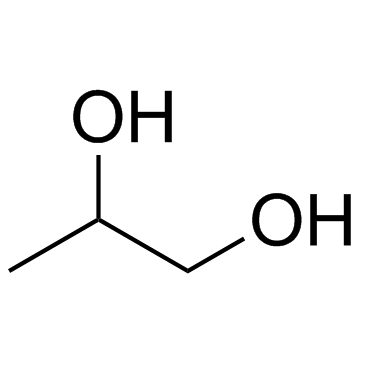Propylene Glycol

Propylene Glycol structure
|
Common Name | Propylene Glycol | ||
|---|---|---|---|---|
| CAS Number | 57-55-6 | Molecular Weight | 76.094 | |
| Density | 1.0±0.1 g/cm3 | Boiling Point | 184.8±8.0 °C at 760 mmHg | |
| Molecular Formula | C3H8O2 | Melting Point | -60ºC | |
| MSDS | Chinese USA | Flash Point | 107.2±0.0 °C | |
|
Comparison of the antifungal efficacy of terbinafine hydrochloride and ciclopirox olamine containing formulations against the dermatophyte Trichophyton rubrum in an infected nail plate model.
Mol. Pharm. 11(7) , 1991-6, (2014) Onychomycosis is a fungal infection mostly induced by dermatophytes such as Trichophyton rubrum. Due to slow nail growth, the treatment takes 3-9 months depending on the nail size and infected area. Hence, high efficacy of the active ingredient without system... |
|
|
The effects of endothelial progenitor cells on rat atherosclerosis.
Biotechnol. Appl. Biochem. 62(2) , 186-92, (2015) Atherosclerosis (AS) is a progressive disease characterized by endothelial injury and lipid aggregation in the arterial walls. Studies have reported that endothelial progenitor cells (EPCs) derived from the bone marrow (BM) might provide an endogenous repair ... |
|
|
Formulation approaches to improving the delivery of an antiviral drug with activity against seasonal flu.
Pharm. Dev. Technol. 20(2) , 169-75, (2015) The main objective of the present study was to develop formulations of noscapine hydrochloride hydrate with enhanced solubility and bioavailability using co-solvent- and cyclodextrin-based approaches. Different combinations of co-solvents, which were selected... |
|
|
Exploring the impact of drug properties on the extent of intestinal lymphatic transport - in vitro and in vivo studies.
Pharm. Res. 32(5) , 1817-29, (2015) Intestinal lymphatic transport of specific lipophilic drugs offers therapeutic advantages and maximises oral bioavailability. The aims of this study were; to compare intestinal lymphatic transport of a range of drugs and to investigate the influence of cyclos... |
|
|
Pharmacokinetics, biodistribution, and toxicity of folic acid-coated antiretroviral nanoformulations.
Antimicrob. Agents Chemother. 58(12) , 7510-9, (2014) The drug delivery platform for folic acid (FA)-coated nanoformulated ritonavir (RTV)-boosted atazanavir (FA-nanoATV/r) using poloxamer 407 was developed to enhance cell and tissue targeting for a range of antiretroviral drugs. Such formulations would serve to... |
|
|
Factors affecting formulation characteristics and stability of ascorbic acid in water-in-oil creams.
Int. J. Cosmet. Sci. 36(5) , 494-504, (2014) The present investigation is based on the formulation of water-in-oil (w/o) cream preparations of ascorbic acid (AA) at pH 4-6 using different emollients and humectants.The preparations were stored in the dark at 30°C for a period of 3 months and were studied... |
|
|
Genotoxicity testing of esterified propoxylated glycerol (EPG).
Regul Toxicol Pharmacol 70 Suppl 2 , S131-42, (2014) Four versions of esterified propoxylated glycerols (EPGs) were evaluated for potential genotoxicity using a range of in vitro and in vivo assays. H-EPG-05 HR/SO 9:1, H-EPG-05 soyate, and H-EPG-14 soyate were non-mutagenic in reverse mutation assays (maximum c... |
|
|
Polymer hydrogel functionalized with biodegradable nanoparticles as composite system for controlled drug delivery.
Nanotechnology 26(1) , 015602, (2015) The possibility to direct pharmacological treatments targeting specific cell lines using polymer nanoparticles is one of the main novelties and perspectives in nanomedicine. However, sometimes, the ability to maintain NPs localized at the site of the injectio... |
|
|
Acetonitrile adduct formation as a sensitive means for simple alcohol detection by LC-MS.
J. Am. Soc. Mass Spectrom. 25(11) , 1987-90, (2014) Simple alcohols formed protonated acetonitrile adducts containing up to two acetonitrile molecules when analyzed by ESI or APCI in the presence of acetonitrile in the solvent. These acetonitrile adducts underwent dissociation to form a nitrilium ion, also ref... |
|
|
Aurora B kinase is a potent and selective target in MYCN-driven neuroblastoma.
Oncotarget 6 , 35247-62, (2015) Despite advances in multimodal treatment, neuroblastoma (NB) is often fatal for children with high-risk disease and many survivors need to cope with long-term side effects from high-dose chemotherapy and radiation. To identify new therapeutic targets, we perf... |